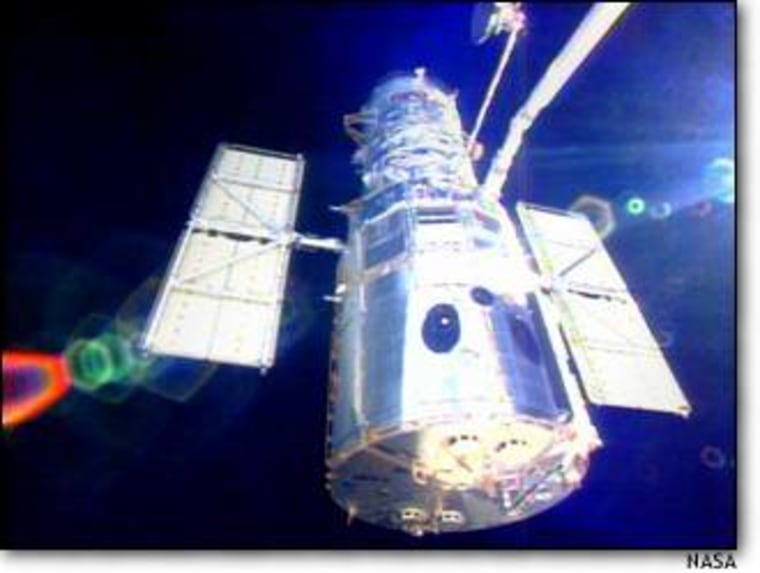In the wake of the space shuttle Columbia disaster, NASA pulled the plug on any plans it had to retrieve the Hubble Space Telescope at the end of its life so it could be displayed in a museum. But a pressing question remained: how to safely deorbit an 11,000-kilogram space observatory that has no onboard means of propulsion. The answer that NASA has all but settled on is to build a roughly $300 million autonomous space tug that would launch on a Delta 2 rocket, grapple Hubble and guide the space telescope safely into Earth’s atmosphere.
The idea is that once the observatory has exhausted its scientific utility it should be carefully de-orbited so it will come down in an unpopulated area.
Hubble, unlike most satellites, has no onboard propulsion system, relying instead on control momentum gyroscopes and flywheels to point the telescope and maintain stability. The entire observatory is boosted whenever a space shuttle visits for a periodic service call.
Michael Moore, NASA’s Hubble Space Telescope program executive, said he hopes to award multiple study contracts in the year ahead to firms interested in building such a system. The proposed project, which has no funding as of yet, would be managed by the Hubble Space Telescope program office at Goddard Space Flight Center in Greenbelt, Md., and would draw on expertise across the agency, Moore said. The price tag for the proposed Hubble disposal mission would be paid for by NASA’s Astronomical Search Origins program, which gets roughly $900 million a year to build and operate space telescopes.
NASA selected the autonomous space tug approach after considering a less technically challenging option: having astronauts attach a propulsion module during the next — and possibly final — Hubble servicing mission. With that mission slated for mid-2006, Moore said NASA would have been hard-pressed to build and test a deorbit stage that could get the job done when the time came without interfering with Hubble science operations in the meantime. But aside from the schedule challenge, NASA faced a very significant logistical challenge. The next Hubble servicing mission, Moore said, is already fully booked. “One of the problems we would run up against would be finding room in the payload bay,” Moore said.
Building an autonomous stage for deorbiting Hubble, Moore said, would buy NASA about six more years to design and build the system and essentially eliminate the risk of doing damage to a valuable science asset. That’s because NASA could wait until Hubble ceases science operations before launching the tug to bring the telescope down. With at least one more servicing mission planned for Hubble in mid-2006, NASA expects the space telescope to last until around 2012.
Ideas solicited
In the meantime, NASA hopes to get started in the year ahead soliciting ideas for the disposal mission. Lockheed Martin, the Bethesda, Md.-based contractor that built Hubble for NASA, has already shared some ideas for the mission with NASA. Chicago-based Boeing Co., which is under contract to conduct an unrelated orbital rendezvous demonstration for the U.S. Defense Advanced Research Projects Agency, or DARPA, in 2006, has also weigh in with ideas.
Moore said he expects the technological risk associated with the Hubble disposal mission to be significantly reduced by a number of orbital rendezvous and satellite servicing demonstrations planned in the years ahead. Those demos include DARPA’s Boeing-led Orbital Express demonstration, the U.S. Air Force’s planned XSS-11 microsatellite experiment, and NASA’s own Demonstration of Autonomous Rendezvous Technology, a planned 2004 flight demonstration led by Dulles, Va.-based Orbital Sciences Corp.
“We actually think that having three programs that are funded right now to look at aspects of this issue are really going to be a great help reducing the risks,” Moore said.
The propulsion module itself will be fairly run of the mill, according to Moore. “The rest of the system is very straightforward,” he said. “It’s off-the-shelf rocket motors, plumbing and avionics.”
NASA has ruled out electric propulsion for the mission, but is considering both mono- and bi-propellant propulsion systems commonly installed on communications satellites for stationkeeping maneuvers.
“We’re generally looking at things in the 100-pound range — more along the lines of oversized attitude control systems,” he said. “The telescope itself is relatively fragile, and we don’t want to go over a certain thrust level. That would complicate our guidance and navigation capabilities tremendously.”
Slow and steady
In other words, slow and steady thrust is all that is needed to ease Hubble out of orbit into a carefully plotted trajectory designed to bring the space telescope down safely into an uninhabited stretch of ocean.
NASA has still not set a definite retirement date for Hubble. Astronomers have been lobbying the agency to keep Hubble on orbit until its successor, the James Webb Space Telescope, has been on orbit for a year or two.
NASA’s Space Science Advisory Committee was debating the merits of an additional Hubble servicing mission during a meeting at the Ames Research Center outside San Francisco during the week of Nov. 15. The advisory panel was expected to forward its recommendation to NASA’s associate administrator for space science, Ed Weiler, in the next couple of weeks, NASA spokesman Donald Savage said Nov. 18.
Brian Berger is a staff writer for Space News.
